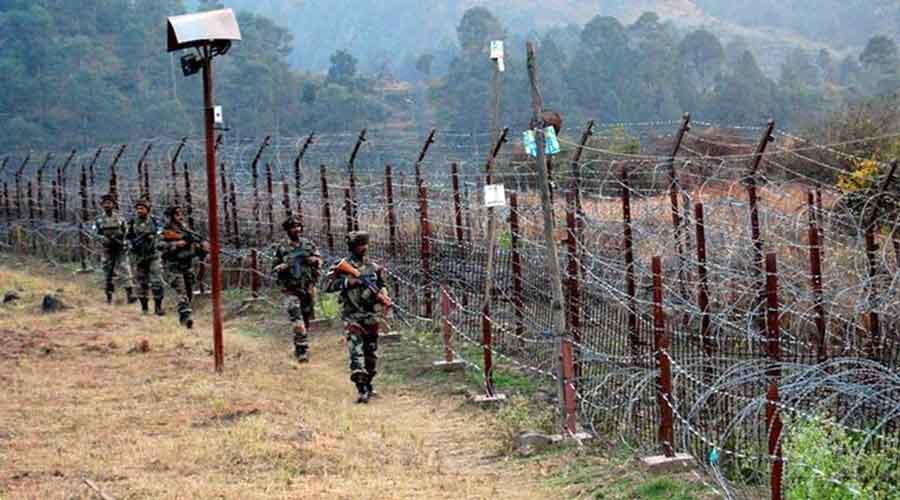Security Challenges and Their Management in Border Area
Introduction: India has a long border of 15,106.7 km shared with seven nations. It shares borders with Pakistan, China, Bangladesh, Myanmar Nepal, Bhutan, and Afghanistan. The country it shares the most border with is Bangladesh and least with Afghanistan. The borders demarcate and define a particular country’s territory where illegal entry of commodities, goods and people is not permitted.
However, these borders are very porous and sometimes are a space of dispute between countries because of vague and unclear demarcation. Border states in India are highly prone and vulnerable to cross border terrorism and organised crime, human trafficking, drug trafficking, smuggling of arms and ammunition, brainwashing people to adopt extremist ways, illegal migration, flaring up of communal tensions, counterfeit currency issues and cunacounted money from other countries that sponsor anti-national activities. Hence, it becomes very important for both psychological and social cohesion of people living in the border states so that they do not remain vulnerable to such activities.
Also Read:
- Disadvantages of Social Media
- Trends That WillEmpower A New India
- Online Making Youth Offline
- Beware of Online Frauds
- Career in Ethical Hacking
-
Bane of Internet Addiction Growing Globally, India too a Victim
Border with Pakistan:

The entire border is manned by BSF except at the LOC which is manned by the Army. Fencing the border has greatly decreased the number of infiltrators inside the country. India-Pakistan border runs through extreme weather conditions of too cold in Kashmir and too hot in the desert of Rajasthan. This poses a greater difficulty in the surveillance of the border areas and for the people living in the border states. On the other hand, the terrain which is difficult to access also becomes a hindrance to the security.
The Indo China Border:
The Indo China border is another subject of controversies because of the recent stand off between the PLA and the Indian Army at the Line of Actual Control. India China has had a history of strained relationships at the border. The 1962 Indo China war where China had an upper hand and India faced damage by losing huge swaths of territory to China. The Doklam issue and the recent Galwan Valley clash is its clear depiction that everything is not fine between the two countries.
The LAC has three sectors: the “western sector” between Ladakh and the Aksai Chin; the “central sector” between Uttarakhand and Tibet; and the “eastern sector” that divides Sikkim and Arunachal Pradesh from Tibet. China is under illegal occupation of areas in Aksai Chin. In the East, it runs along the McMahon Line as per Indian perception whereas China claims that the entire state of Arunachal Pradesh is Chinese territory and part of Southern Tibet and India is under illegal occupation of Chinese territory. Regardless, India is one of the largest trading partners of China. And both the countries have similar aspirations in the United Nations, for example the democratization of IMF and World Bank. Both being the developing countries have also voiced strong opinions on climatic change and how developing countries are facing the blunt of undoing the climatic change by the developed countries.
BRICS organization of 5 countries which has resulted in forming of New Development Bank to help each other grow through investments. India-China is a Joint Economic Group on Economic Relations, Trade, Science and Technology. SCO is a strategic organization led by China for peace and stability in Asian countries. These organizations have helped in the occurrence of healthy dialogue between two countries. However China’s One Belt One Road initiative has acquired support of different countries surrounding India and its increased assertiveness in the Indo Pacific and the South China is a matter of concern for India. Most part of the border is guarded by ITBP, mostly headed by IPS officers who report to the Home Ministry. But some parts are also guarded by the Army which is under the Defence Ministry. China’s plan to harness Brahmaputra river has also triggered anxiety in India and Bangladesh
India, Bhutan & Nepal:
India and Bhutan have had years of friendship and exemplify what true neighbors should be and how cooperation looks like. Bhutan and India have always stood through thick and thin. India and Nepal signed a Treaty of friendship in the year 1950 and both the countries have had good relationships. Many factors make India’s relationship with Nepal critical. These include the extensive people-to-people, religious, cultural and economic links between the two countries, the open border and the resultant security problems for India, free Indian currency convertibility in Nepal, the presence of Gorkhas in the Indian Army, the millions of Nepalese living and working in India , and the flow of major rivers from Nepal to India. Since the eruption of a Maoist insurgency in Nepal efforts have been made to gradually step up vigilance along this border as India fears the southward spread of Maoist ideology. BBIN, SAARC are multilateral platforms that would increase the engagement of both the countries.
India & Bangladesh: India Bangladesh have had great diplomatic relations and both the countries co-operate at all levels very well with each other from people to people ties, cultural contacts, and trade relations. The border areas of both the countries face a lot of threat from illegal migrants entering India through the North East States of India and creating mayhem. Drug trafficking and human trafficking is another area of concern. India Bangladesh Land Boundary Agreement came into force in the year of 2015.
India & Myanmar: India Myanmar share cultural, ethnic, religious and historical ties. The border is porous, so there is considerable illegal migration, human trafficking and infiltrators that enter India and find safe haven in the northeast. The Nagas and Mizos with separatist ideologies cross the border and reach Myanmar to undergo training. Several insurgent groups have secured sanctuaries in Myanmar. The junction of India, Bangladesh and Myanmar is also vulnerable due to the Chakma problem and frequent infiltration of Muslims from Myanmar to Bangladesh. Rohingya crisis is one of them.
Conclusion: Thus, we see how these border areas are an area of concern. The security of the country can be assured with regular patrolling, deployment of technology and high tech devices like sensors, cameras, UAVs, drones, reconnaissance and surveillance devices, border security outposts, Border fencing, modern offensive systems, such as high-tech artillery and troop deployment can only be realized effectively when augmented with essential research and intelligence-based activities.
The world is moving towards technologically advanced military and defence systems and India has been equipping its military with sophisticated weaponry. Increased bilateral and multilateral cooperation, coupled with the adoption of new technologies for border control and surveillance and the development of integrated systems for entering, exchange and storage of data, will facilitate the movement of people and products without endangering security.













































